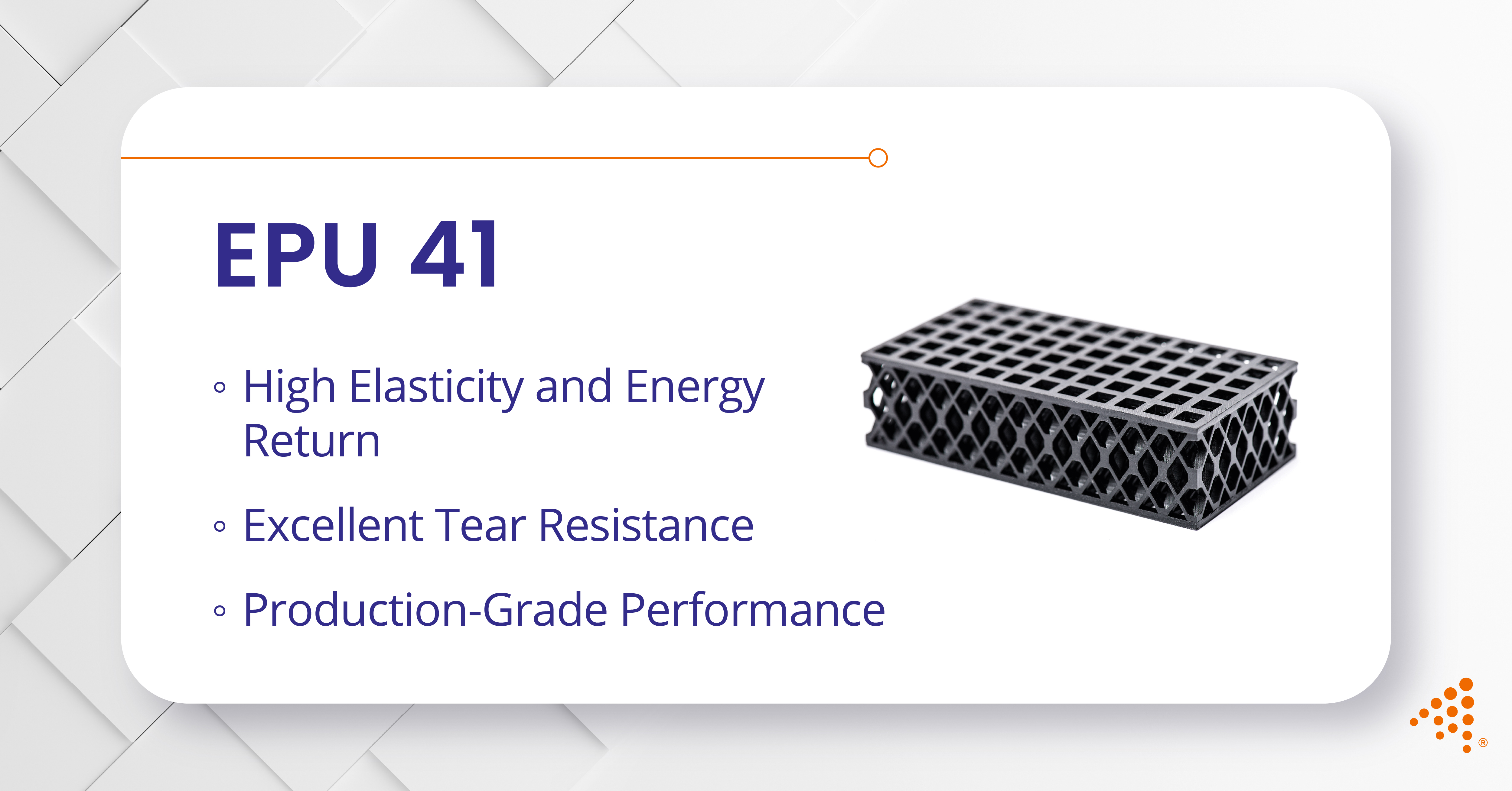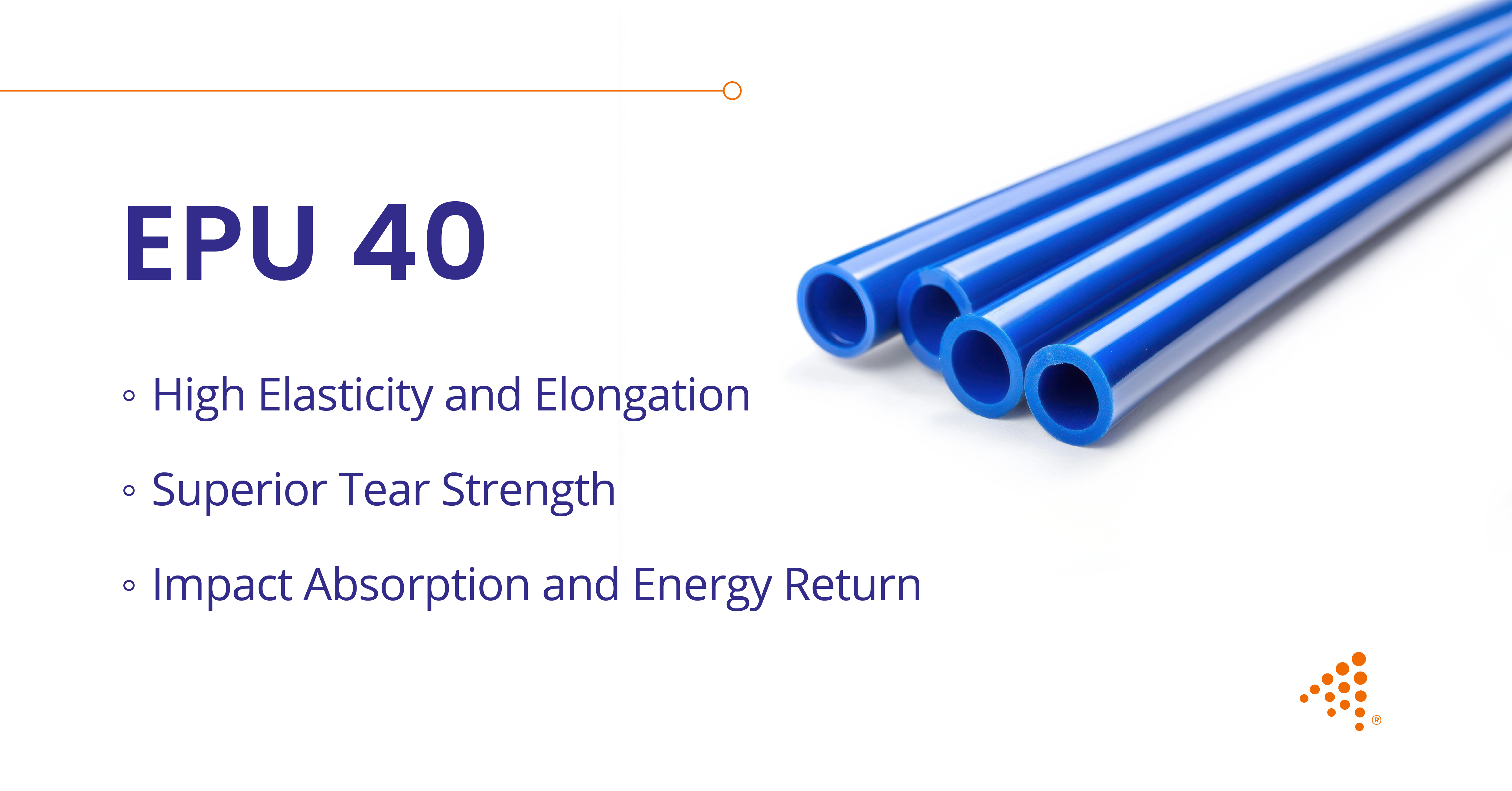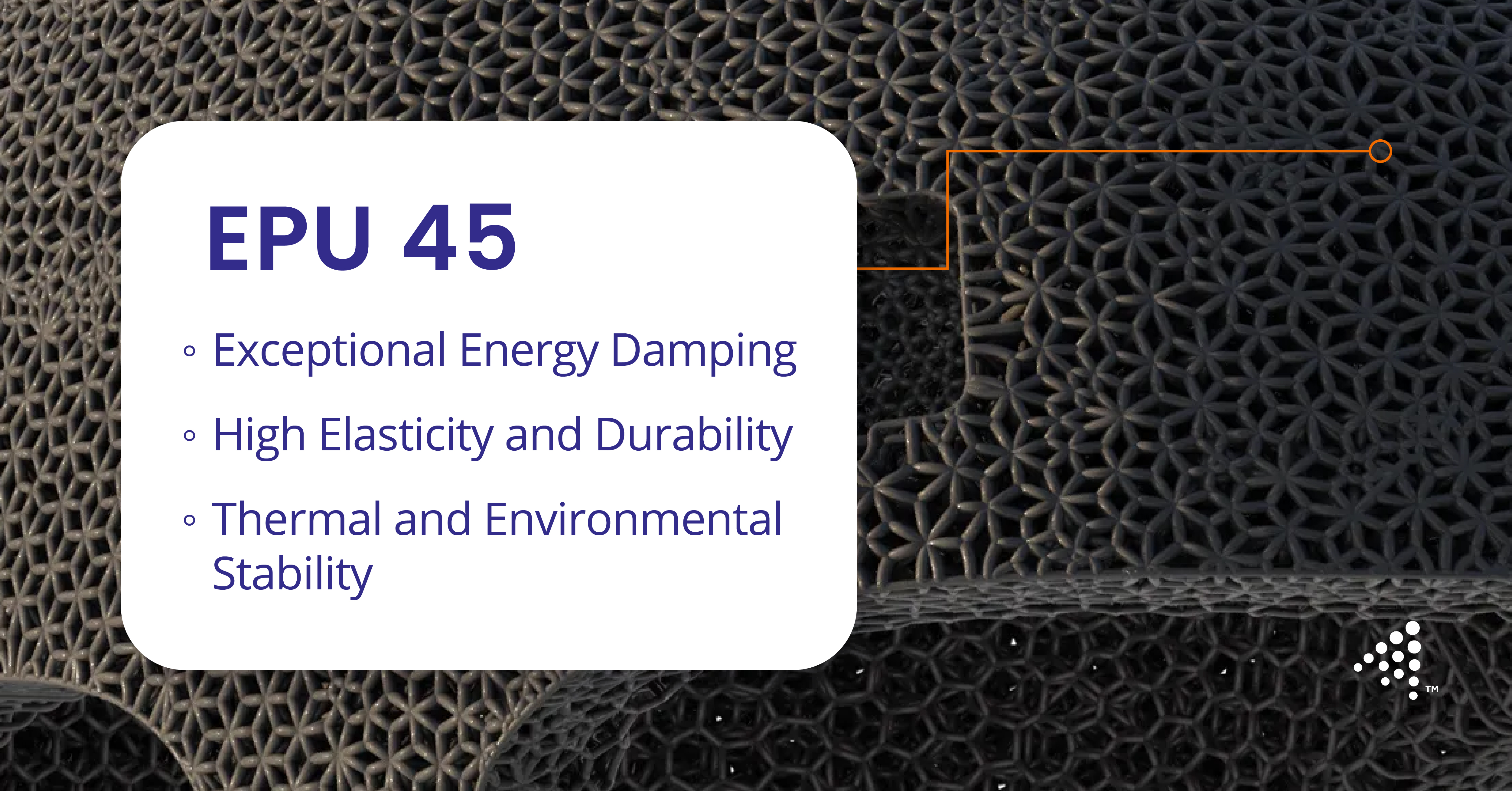EPU 40: Elastic, Tear-Resistant, Energy-Damping Resin
Elastomeric Polyurethane (EPU 40) is a high-performance additive manufacturing material developed by Carbon, renowned for its unique combination of...
5 min read
Nick Erickson : Jul 18, 2025 9:07:00 AM

Elastomeric Polyurethane (EPU 41) is a versatile, production-grade additive manufacturing resin developed by Carbon. It is engineered to deliver parts with exceptional elasticity, tear resistance, and resilience, making it suitable for a wide array of uses, particularly w here rubber-like flexibility and durability are paramount. EPU 41 stands out for its ability to produce functional elastomeric components that can withstand rigorous operational demands, bridging the gap between prototyping and full-scale production.
EPU 41 is distinguished by a set of properties that make it a strong candidate for elastomeric parts, including those found in complex medical injection molding assemblies.
EPU 41 exhibits significant elasticity, allowing it to stretch and flex considerably before returning to its original shape. This high energy return means it can absorb and dissipate energy effectively, which is crucial for components subjected to repeated stress or impact. Its elongation at break is noteworthy, providing substantial deformation capacity without failure.
One of the hallmark features of EPU 41 is its robust tear strength. This characteristic allows parts printed with EPU 41 to resist the propagation of tears, even when nicked or punctured. This durability is especially beneficial for components that experience dynamic loads or harsh handling conditions.
With a Shore A hardness typically around 73, EPU 41 offers a good balance between flexibility and firmness. This durometer places it in the range of medium-soft rubbers, making it suitable for parts that need to be pliable yet maintain their structural integrity, such as seals, gaskets, and cushioning elements.
EPU 41 has successfully passed testing for USP Class VI and ISO 10993-5 (cytotoxicity) and ISO 10993-10 (irritation and sensitization). This level of biocompatibility makes it a viable option for select medical device components, particularly those intended for skin contact or other non-implantable uses. This opens avenues for its use in creating patient-specific medical equipment.
This material demonstrates good resistance to a variety of common chemicals. However, it is generally not recommended for prolonged exposure to strong acids, bases, or certain organic solvents. For specific chemical compatibility, testing under end-use conditions is advisable.
EPU 41 is designed for producing end-use parts at scale. Its mechanical properties are reliable and consistent, allowing manufacturers to move beyond prototyping into serial production for elastomeric components that meet demanding performance criteria. The precision of the Carbon DLS™ process combined with EPU 41 allows for the creation of intricate elastomeric lattices and complex geometries that would be difficult or impossible with traditional injection molding techniques.
Looking for Superior Elasticity and Energy Return?
Discover how EPU 41 can enhance your product's durability and flexibility.
The unique combination of elasticity, durability, and biocompatibility makes EPU 41 a preferred material across several industries, especially for components that require rubber-like performance.
Due to its excellent elasticity and good compression set, EPU 41 is frequently used to create custom gaskets and seals. These components can provide tight, durable seals for enclosures, preventing ingress of dust or moisture in a variety of devices, including medical equipment and consumer electronics. Flexible housings that require impact absorption also benefit from EPU 41.
The high energy return and damping characteristics of EPU 41 make it effective for cushioning pads, shock absorbers, and vibration isolators. These can be integrated into industrial machinery, protective gear, or sensitive electronic assemblies to mitigate impact forces and reduce operational noise.
Given its biocompatibility credentials, EPU 41 is suitable for various non-implantable medical device parts. Examples include flexible tubing connectors, custom-fit seals for diagnostic equipment, soft-touch grips for medical instruments, and patient-specific cushioning elements for wearable devices or prosthetics.
The flexibility, tear resistance, and skin-contact safety of EPU 41 lend themselves well to the rapidly growing fields of wearable technology and soft robotics. It can be used for straps, flexible joints, or compliant grippers that require both durability and safe interaction with users.
For devices and equipment needing protection from drops or impacts, EPU 41 can be fashioned into resilient covers, bumpers, and overmolds. Its ability to absorb energy helps safeguard sensitive internal components.
Read More About How to Place a Prototype Package Order Through Aprios Online Quotes
EPU 41 is often compared to Thermoplastic Polyurethanes (TPUs) with a Shore A hardness in the range of 70-90, which are commonly used in traditional injection molding. While both EPU 41 (a thermoset polyurethane processed via additive manufacturing) and TPUs (thermoplastics) provide elastomeric properties, there are key distinctions in their behavior and processing.
TPUs in this durometer range are known for their good abrasion resistance, elasticity, and toughness, making them suitable for many of the same types of uses as EPU 41, such as seals, flexible connectors, and shock-absorbing elements. Like EPU 41, certain grades of TPU can also offer biocompatibility for medical product development. Both material families generally exhibit good resistance to oils and greases, though specific chemical compatibilities can vary.
However, EPU 41, when produced using Carbon's DLS™ technology, offers distinct advantages in terms of design freedom and part complexity. The additive nature allows for the creation of intricate internal lattice structures and consolidated assemblies that would be difficult or prohibitively expensive to achieve with TPU injection molding, which requires dedicated tooling. EPU 41 parts tend to exhibit more isotropic mechanical properties, meaning their strength and flexibility are more uniform in all directions, unlike injection-molded TPU parts, where material flow during molding can lead to anisotropic behavior. Furthermore, EPU 41's formulation is specifically optimized for high elastic return and resilience, which can be a distinguishing factor in dynamic applications where energy absorption and recovery are critical. While TPUs are highly versatile, the rapid iteration and tool-less production offered by EPU 41 can be particularly beneficial for custom or low-to-mid-volume production runs.
While EPU 41 offers many advantages, there are certain considerations to keep in mind when selecting it for a project.
The natural, translucent variant of EPU 41 can yellow over time with prolonged exposure to ultraviolet (UV) light. For components where color stability under UV is critical, Carbon offers EPU 41 Black, or the use of a UV-blocking coating or paint is recommended.
EPU 41 has a heat deflection temperature of approximately 115°F (46°C) at 0.455 MPa. This means its mechanical properties may begin to degrade in environments consistently above this temperature, limiting its use in high-temperature settings. For higher temperature elastomeric needs, alternative materials might be more appropriate.
While generally robust, EPU 41 is not universally resistant to all chemicals. As mentioned, prolonged contact with strong acids, strong bases, or certain aggressive organic solvents can cause degradation. Thorough testing in the intended chemical environment is always a prudent step.
For extremely high-volume production runs (many hundreds of thousands or millions of parts), traditional injection molding of a comparable TPU might eventually offer a lower per-part cost due to the economies of scale associated with molding, once tooling costs are amortized. However, for low to moderate volumes, or where complex designs and rapid iteration are valued, EPU 41 often presents a more economically viable and flexible solution.
Read More About Nylon (Polyamide): Durable and Versatile for Many Applications
EPU 41 is an exceptional choice when your project demands a resilient, tear-resistant elastomer capable of producing complex geometries and performing reliably in demanding, real-world conditions. Its combination of high elasticity, good energy return, and biocompatibility (USP Class VI, ISO 10993-5 & -10 compliance) makes it particularly well-suited for advanced prototypes, functional components in medical devices, durable seals and gaskets, and innovative wearable technologies.
The ability to leverage Carbon DLS™ technology with EPU 41 means that product developers can achieve intricate designs and internal lattice structures that are often impractical or impossible with conventional manufacturing methods like injection molding. This allows for part consolidation, weight reduction, and performance optimization. If your parts need to withstand repeated motion, absorb impacts, or provide a reliable, flexible interface, EPU 41 provides a production-grade solution that can accelerate your product development and manufacturing cycles. Its performance characteristics are particularly beneficial in sectors that demand both durability and material safety.

Elastomeric Polyurethane (EPU 40) is a high-performance additive manufacturing material developed by Carbon, renowned for its unique combination of...

Elastomeric Polyurethane 44 (EPU 44) is a highly elastic and tear-resistant material developed by Carbon for its Digital Light Synthesis™ (DLS)...

Elastomeric Polyurethane (EPU) 45 is a high-performance photopolymer resin engineered for the Carbon Digital Light Synthesis™ (DLS™) process. This...